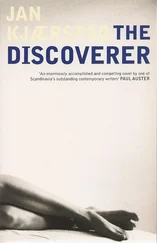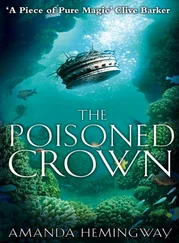Jan Kjaerstad - The Seducer
Здесь есть возможность читать онлайн «Jan Kjaerstad - The Seducer» весь текст электронной книги совершенно бесплатно (целиком полную версию без сокращений). В некоторых случаях можно слушать аудио, скачать через торрент в формате fb2 и присутствует краткое содержание. Год выпуска: 2006, Издательство: Overlook, Жанр: Современная проза, на английском языке. Описание произведения, (предисловие) а так же отзывы посетителей доступны на портале библиотеки ЛибКат.
- Название:The Seducer
- Автор:
- Издательство:Overlook
- Жанр:
- Год:2006
- ISBN:нет данных
- Рейтинг книги:5 / 5. Голосов: 1
-
Избранное:Добавить в избранное
- Отзывы:
-
Ваша оценка:
- 100
- 1
- 2
- 3
- 4
- 5
The Seducer: краткое содержание, описание и аннотация
Предлагаем к чтению аннотацию, описание, краткое содержание или предисловие (зависит от того, что написал сам автор книги «The Seducer»). Если вы не нашли необходимую информацию о книге — напишите в комментариях, мы постараемся отыскать её.
The Seducer — читать онлайн бесплатно полную книгу (весь текст) целиком
Ниже представлен текст книги, разбитый по страницам. Система сохранения места последней прочитанной страницы, позволяет с удобством читать онлайн бесплатно книгу «The Seducer», без необходимости каждый раз заново искать на чём Вы остановились. Поставьте закладку, и сможете в любой момент перейти на страницу, на которой закончили чтение.
Интервал:
Закладка:
Armauer Hansen had spent some time in Vienna as part of a study tour and divided his time there between dining with Norwegian colleagues, frequenting the cafés, working in the laboratory and going to the theatre. One day he popped into a bookshop and happened — quite by chance — to come across a book: Ernst Haeckel’s mammoth work, Natürliche Schöpfungs-geschichte . Here, in Vienna, Austria, just after the end of the Franco-Prussian war, Armauer Hansen found the key to his quest for the cause of leprosy, because it was in this book that he first came upon Darwin’s theories of which, prior to this, he had not heard so much as a whisper: ‘At the time I was extremely shocked by how cut off from the world Norway was; as a student I had not heard one word about this man Darwin or his theories, neither at the University nor among my own circle of acquaintances.’ His encounter with Darwin gave Armauer Hansen a new view of scientific research techniques, above all of the need to rid oneself of all preconceived notions. One should not speculate but observe coolly and objectively. Thus Armauer Hansen was shaken out of his acquired ideas about lepra.
Viewers particularly remembered how Jonas Wergeland, by dint of a hand-held camera in constant, febrile motion, together with unusual backing music, had created the most unbearable suspense in the bookshop sequence — on paper a pretty insignificant scene. With the aid of Paintbox, Haeckel’s book had been made to glow like a gold ingot on its shelf, while Armauer Hansen wandered round and round in circles, rather like a game of ‘Hunt the Thimble’, for so long that viewers were all but shouting out, like children, ‘There! Over there! On the shelf to the left!’ Many also recalled the exquisite exteriors from Vienna, shots of Armauer Hansen sitting reading in various locations — some familiar, others less so — around the old imperial capital. A pipe-smoking Armauer Hansen, with his bushy beard and large, broad-brimmed hat. ‘I saw the entire world in a new light,’ he was later to write, a fact which was illustrated on film by a sort of dawn light, long panning shots and by constantly cutting back to Armauer Hansen with his nose in a book — this image of a Norwegian in a European city being confronted with ideas that were not available in his own country, ideas that opened his mind, enabling him to make that crucial incision with the scalpel through the fixed notions, the dogmatic medical theories of his day and their overpowering hold on the mind. The images of Armauer Hansen in Vienna spoke of a revelation, of a joyously creative moment.
In a relatively short, almost superfluous, scene inserted before the standard spot featuring the snide ‘who does he think he is?’ whisperers, the programme showed Armauer Hansen back home at Lungegaard Hospital pursuing his theory that a tiny microorganism might be the cause of leprosy, an idea that did not have too many supporters but which finally, despite the primitive techniques for identifying microbes, led to his discovery of the minute rod-shaped organisms, Mycobacterium leprae , in a sample taken from a knot on the face of a patient and to the publication of the work Investigations into the Causes of Leprosy , in which Armauer Hansen proved that a virus lay at the root of a chronic disease.
And, if I might add my two penn’orth, it was high time that the Norwegian people were reminded of this brilliant achievement, one of the few truly original Norwegian contributions to the incredibly difficult, and yet universally vital, art of getting to grips with cause and effect.
The Kama Sutra in Norwegian
I have not forgotten what I set out to tell you, since all of this leads us up to, or back to, the body, an awareness of the body: Jonas Wergeland, the boy Jonas, standing by the chink in the door watching his naked parents rolling about on the rug, acting out that drama which certain psychologists, with as great a knack for exaggeration as the opera, have called ‘the primal scene’. And on one point at least the psychologists have been proved right; Jonas would never forget it.
For ages he stood there, watching his parents, not knowing that this sight in itself was astonishing enough: a couple making the moment last, taking their time to extract every ounce of pleasure from making love. Standing in the dark in the hallway, he felt the same spontaneous, awestruck admiration as he did when faced with one of Uncle Lauritz’s beautiful Caravelles, and as he watched he was struck by a two-way perception. On the one hand he saw how the familiar living room was altered by the act of love being performed on the rug; how the hessian wallpaper, the Negro lady on the wall — that piece of high kitsch — the new corner sofa, the bookshelf full of books that no one read, the cuckoo clock that was always an hour slow, how all of this tipped over into another dimension; were it not such a misleading word I would go so far as to say it was sanctified . Even something as dubious as the Negro lady on the wall acquired something of the air of an icon.
On the other hand, Jonas perceived this scene with his mother and father as a secularizing of sexuality, because simply by lying there naked on the rug, between the two chairs in which they usually sat and talked, totally absorbed in a long luscious screw — and transmitting, in the process, a highly graphic odour to Jonas’s nostrils — his parents brought all of the abstract and stiff and stylized prose Jonas had read in his Danish edition of the Kama Sutra , into everyday life, into his own living room, presenting it as a concrete, demystified possibility. Jonas watched his mother and father to some extent transplanting the teachings of the Kama Sutra into Norwegian soil.
Jonas tried to keep track of what was going on, concentrating not so much on their genitals as on the playful, constantly shifting positions of their bodies, and during the time he stood there, he was quite certain that he saw illustrated such hitherto mysterious phenomena as ‘the Coral and the Gemstone’, ‘the Bull’s Blow’ and ‘Sparrow Sport’, while his parents demonstrated, at least so he thought, such variations as the twining position, ‘the Crab’s position’ and ‘the congress of a Cow’. At one point he also saw his mother do something to his father which, going by the look of ecstasy on his father’s face, Jonas guessed must be the position known as ‘Tongs’, in which his mother sat on top of him and spun round tentatively like a wheel, something which did not fail to impress Jonas, since this was described as being the ‘absolute ultimate’, a position that could only be mastered by long practice, a sort of sexual ‘C’ element. All in all, this experience reinforced a feeling that Jonas had always entertained for his mother and father: respect.
There was one detail above all else which brought home to Jonas just what an uncommonly pleasurable experience he was witnessing. His mother was not wearing her usual wry smile. She lay with her eyes closed, her lips curling into a quite different smile, an ardent, deeply contented smile.
Which reminds me that I have not told you the story of why Jonas’s mother always had a wry little smile on her face as if she knew something that no one else knew. Again this has to do with speed-skating, with one of the most traumatic incidents in the whole of Norwegian skating history as a matter of fact. It occurred during the European championships at Bislett stadium in the fifties. Haakon Hansen, who happened to be a keen skating enthusiast, had arranged a babysitter for Rakel so that Åse, who had never attended a speed-skating tournament, could come with him. It was a Sunday in late January, the weather more like autumn than winter. Haakon Hansen was in his element, providing explanations and an enthusiastic commentary all the way through the 1500 metres, while Åse grew more and more bored, finding it hard to understand how her husband and all the other spectators could become so carried away, particularly seeing that the Norwegian skater Hjalmar, known to all Norway as Hjallis, or the ‘Happy King’ because of his lovely smile, dominated the whole proceedings so completely and was so devastatingly far ahead of the field overall that the final race, the 10,000 metres was anything but exciting. Åse Hansen, Jonas’s mother, was both cold and bored to death, standing beside her husband right next to the track, down by the southern curve, watching Hjallis skimming past, lap after lap, already pointedly looking for the Dutchman Wim van der Voort. To relieve the boredom slightly she nibbled at a bar of Freia milk chocolate which she had bought during the interval before the 10,000 metres, and it was during the seventeenth lap of this by now thoroughly unexciting 10,000-metre race, with the crowd, Haakon Hansen included, nonetheless cheering and yelling as if possessed, as she popped the last square of chocolate into her mouth, that the wind caught the silver paper and blew it out onto the track. Åse Hansen began to take an unexpected interest in this piece of silver paper of which no one else had taken any note and which lay, all but invisible, on the ice. Hjallis was coming down the changeover straight, when she noticed with growing excitement how a gust of wind caught the nigh-on invisible slip of silver paper and swept it low across the ice to land at the end of the inner curve just as Hjallis turned into it. Åse Hansen suddenly conceived an enormous interest in speed skating. She held her breath as Hjallis powered round the bend in the style for which he was so well known. Then it happened: a disaster, in Norwegian eyes, of earthquake proportions which made the front-page headlines in all the newspapers the next day; Hjallis, the national hero, fell. Hjallis’s right skate came down smack-dab on the silver paper, the blade met no resistance, his foot went flying backwards, and Hjallis lost his balance, fell headlong and went flying into a pole, damaging one skate in the process. The Happy King, not smiling now, got up and tried to go on, but it was no use, the skate was a write-off. He had to give up. The crowd, and not least Haakon Hansen, stared in disbelief, stunned, close to tears if the truth be told. Åse Hansen, too, was battling with her emotions, desperately trying not to laugh.
Читать дальшеИнтервал:
Закладка:
Похожие книги на «The Seducer»
Представляем Вашему вниманию похожие книги на «The Seducer» списком для выбора. Мы отобрали схожую по названию и смыслу литературу в надежде предоставить читателям больше вариантов отыскать новые, интересные, ещё непрочитанные произведения.
Обсуждение, отзывы о книге «The Seducer» и просто собственные мнения читателей. Оставьте ваши комментарии, напишите, что Вы думаете о произведении, его смысле или главных героях. Укажите что конкретно понравилось, а что нет, и почему Вы так считаете.












